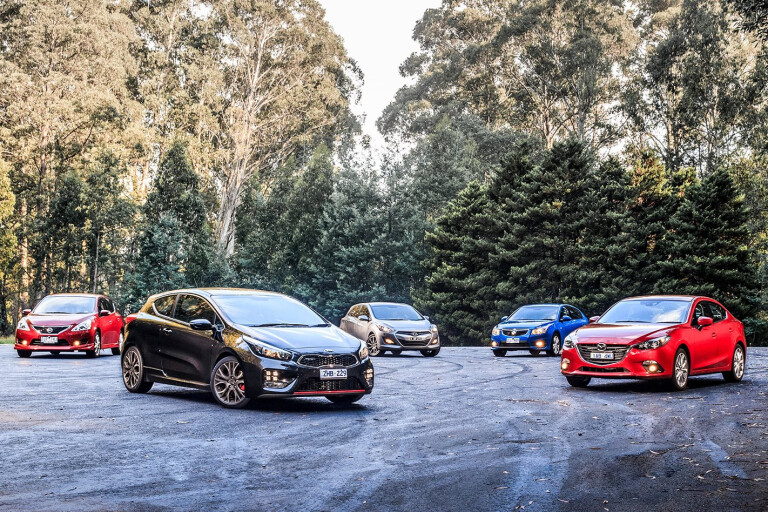
We’d all love an HSV, AMG or 911 in the driveway, but the realities of life, or budget, often mean settling for something further down the food chain.
That’s no excuse for abandoning the enthusiast church, of course. Quite a few manufacturers now offer warmed-up versions of their humble hatchbacks, so we’ve gathered together five examples (okay, one’s a sedan) to find out if any are able to serve up champagne motoring on a beer budget.
Some unfamiliar names, at least to the pages of MOTOR, pop up at this end of the market. Hyundai and, in particular, Kia, are in their infancy when it comes to performance metal, and each is taking a different approach.
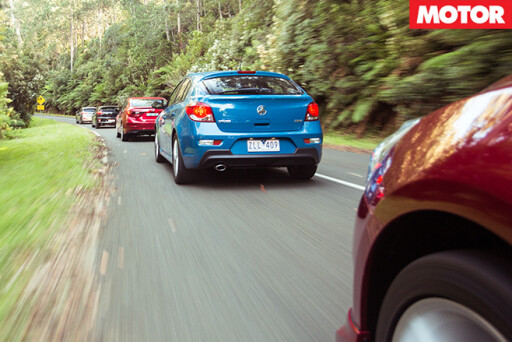 Hyundai has dipped a toe into the local market with the warmed-over $25,590 i30 SR, whereas Kia is diving in head first with the ProCeed GT which, at $29,990, is the most expensive car here.
Hyundai has dipped a toe into the local market with the warmed-over $25,590 i30 SR, whereas Kia is diving in head first with the ProCeed GT which, at $29,990, is the most expensive car here.
How times change.
Joining these two Seoul mates is another car with a strong Korean connection, the Holden Cruze SRi. Primarily designed and engineered by GM Daewoo in South Korea, the global reach of Holden’s locally-assembled hatch allows it to be offered for a bargain basement $23,140. Cheap and cheerful? We’ll see.
Meanwhile Mazda’s been playing in the warm hatch sandpit longer than most, starting with the SP20 back in 2001, but the latest SP25, sharply priced at $25,190, is a classier, more grown-up effort – but behind the wheel, does it still know how to entertain?
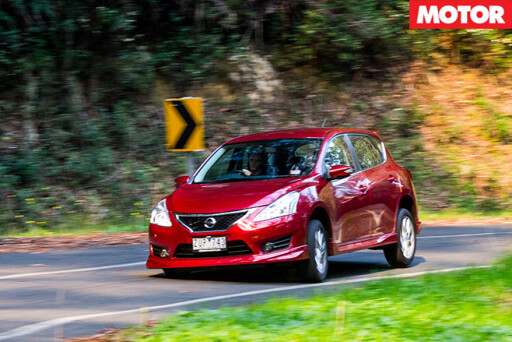 Rounding out this cut-price crew is the welcome return of a famous Aussie nameplate, the Nissan Pulsar SSS. At $25,090, the SSS offers a hell of a lot of bang for your buck.
Rounding out this cut-price crew is the welcome return of a famous Aussie nameplate, the Nissan Pulsar SSS. At $25,090, the SSS offers a hell of a lot of bang for your buck.
The Pulsar’s 1.6-litre direct injection turbo four offers a handy 140kW/240Nm, with a broad spread of power and great response. A pity, then, that it sounds like a dying sewing machine. Still, with close gearing, a quick shift and just 1304kg to pull, it’s good enough for 0-100km/h in 7.8sec and a 15.56sec quarter.
Only the Kia is faster, and that’s as much down to its superior traction as its extra 10kW/25Nm.
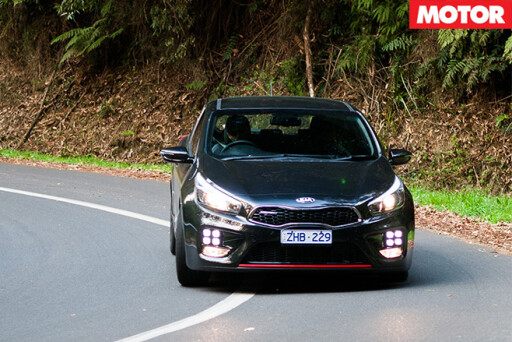 Whereas the Pulsar vaporises its front tyres launching at anything more than 2500rpm, the ProCeed keeps going faster the more revs are dialled up, around 4500rpm delivering 0-100km/h in 7.45sec (Kia claims 7.7) and 0-400m in 15.34sec.
Whereas the Pulsar vaporises its front tyres launching at anything more than 2500rpm, the ProCeed keeps going faster the more revs are dialled up, around 4500rpm delivering 0-100km/h in 7.45sec (Kia claims 7.7) and 0-400m in 15.34sec.
Kia’s 1.6-litre direct-injection ‘Gamma’ turbo four favours torque over top-end heroics, with a strong, linear power curve and 80 per cent of its 265Nm peak on tap from 1500rpm.
Sadly, it sounds far better outside than from within and while I personally have no problem with the light, reasonably precise gearshift, not everyone is a fan.
Proving that adding a turbo doesn’t automatically make for a drag strip weapon is the Cruze.
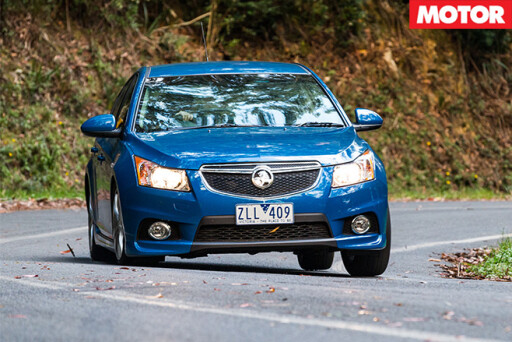 Last to 100 (8.81sec) and over the quarter (16.32sec) with the slowest terminal speed (137.36km/h), the current car’s 132kW/230Nm turbo 1.6 is a welcome step up over the old SRi’s 103kW/200Nm turbo 1.4, but the engine characteristics remain oddly similar. There’s decent mid-range urge, but it feels disinterested at higher rpm. A portly 1460kg kerb weight does it no favours.
Last to 100 (8.81sec) and over the quarter (16.32sec) with the slowest terminal speed (137.36km/h), the current car’s 132kW/230Nm turbo 1.6 is a welcome step up over the old SRi’s 103kW/200Nm turbo 1.4, but the engine characteristics remain oddly similar. There’s decent mid-range urge, but it feels disinterested at higher rpm. A portly 1460kg kerb weight does it no favours.
The Hyundai is little faster but more rewarding, thanks to its 129kW/209Nm 2.0-litre atmo four revving out to almost 7000rpm, though it needs every rev to give its best. Even then, 0-100km/h in 8.55sec and a 16.18sec quarter mile is nothing to crow about.
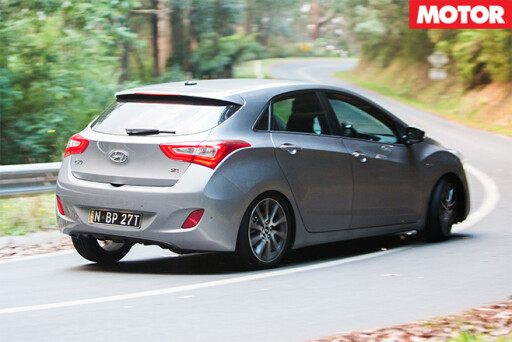 Hampering the i30’s efforts is oddball gearing; the 1-2 shift is fine, but then there’s a yawning chasm to third, and the process repeats itself on the jump to fifth and sixth.
Hampering the i30’s efforts is oddball gearing; the 1-2 shift is fine, but then there’s a yawning chasm to third, and the process repeats itself on the jump to fifth and sixth.
Nowhere is this more evident than the Hyundai’s boredom-inducing 19.6sec 80-120km/h time in sixth gear – we almost ran out of drag strip. For reference, the Kia and Nissan dispatch the same increment in around nine seconds.
With its ‘big block’ 138kW/250Nm 2.5-litre four, the Mazda feels much stronger, so its relatively lacklustre figures (8.39sec 0-100km/h; 15.95sec 0-400m) come as
a surprise.
The extra capacity is a curse as much as a blessing, the SP25 torching its tyres if attempting a launch at any more than 2000rpm. Away from the drag strip, however, the Mazda’s atmo donk comes alive, with plenty of grunt and throttle response the turbo cars can only dream of.
 Thanks to its clever, ultra-high compression (13:0.1) tune, the SP25 also leads the way at the bowser, its parsimonious 8.1L/100km just pipping the i30 (8.2L/100km) and Pulsar (an impressive 8.9L/100km).
Thanks to its clever, ultra-high compression (13:0.1) tune, the SP25 also leads the way at the bowser, its parsimonious 8.1L/100km just pipping the i30 (8.2L/100km) and Pulsar (an impressive 8.9L/100km).
Chugging down the 98RON like it’s O-week are the Kia (10.1L/100km) and Cruze (10.6L/100km). There’s a certain irony this push to forced induction is aimed at reducing fuel consumption, yet in the real world it’s having precisely the opposite effect.
The moment the road deviates from the straight-ahead, the pecking order gets turned on its head. All five have their own strengths and weaknesses, and while you might think down here in sub-$30K land the driving experience will be separated only by levels of blandness, each has its own character.
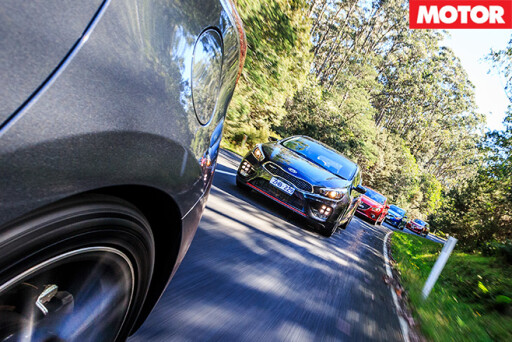 In fact, it’s remarkable how the way each contender looks is representative of how it drives.
In fact, it’s remarkable how the way each contender looks is representative of how it drives.
Standing tall on its skinny 205/50 R17 Continental rubber, the Pulsar looks like it’s up on tiptoes before a wheel has turned. You sit high with the wheel slightly offset to the left, a wheel you’re left clinging desperately to thanks to the front seats’ lack of lateral support.
 Slow steering (3.4 turns lock-to-lock) that offers next to no connection to the front wheels, substantial body roll and limited tyre grip make the SSS a rather unsatisfying car to drive quickly.
Slow steering (3.4 turns lock-to-lock) that offers next to no connection to the front wheels, substantial body roll and limited tyre grip make the SSS a rather unsatisfying car to drive quickly.
It’s very difficult to get a sense of what the car is doing and if you do overcook it, the ESP usually seems to be in the middle of a siesta. Add in that it feels faster than all else here and you’re left with the impression this is an engine crying out for a more capable chassis.
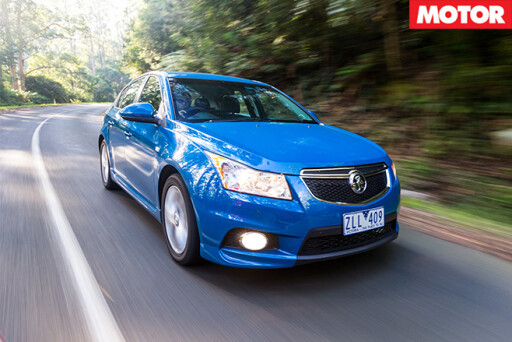 The Cruze on the other hand is almost exactly the other way around. Like the Pulsar, the Holden is quite soft in its setup, but it has a level of control and precision completely lacking in the Nissan.
The Cruze on the other hand is almost exactly the other way around. Like the Pulsar, the Holden is quite soft in its setup, but it has a level of control and precision completely lacking in the Nissan.
The steering is very sharp off-centre – almost too sharp – but once acclimatised you begin to enjoy the way the Cruze pivots through a corner using all four tyres rather than leaning on the fronts. Grip levels are high thanks to sticky Bridgestone Potenza RE050A tyres and the compliant chassis feels expertly tuned to local roads.
Trouble is, you’re too often driving the Cruze with your right foot welded to the firewall, hoping an extra 30kW will materialise if you concentrate hard enough.
A similar problem afflicts the i30 SR. There’s genuine fun to be found in the Hyundai’s handling, but its lack of poke means it’s definitely a car best enjoyed downhill.
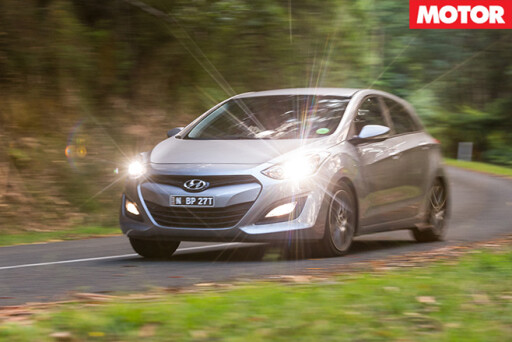 Hyundai’s local development team has concocted a fine mix of steering response, damping compliance and handling adjustability, though a number of testers feel it would benefit from better tyres than the OEM Hankook Ventus Primes, with wheelspin in slower corners and plenty of tyre squeal in faster ones.
Hyundai’s local development team has concocted a fine mix of steering response, damping compliance and handling adjustability, though a number of testers feel it would benefit from better tyres than the OEM Hankook Ventus Primes, with wheelspin in slower corners and plenty of tyre squeal in faster ones.
Just how much of a handicap the standard rubber is becomes abundantly clear the moment the heavens open. Leading the pack through Victorian back roads, the first damp corner encountered is a long, sweeping left-hander. Taken at a brisk but far from breakneck 100km/h (the posted speed limit), the front instantly washes wide, quickly joined by the tail trying to overtake.
I slow immediately following this heart-stopping moment, convinced there’s oil or diesel on the road, only to be met by quizzical looks from the others who negotiated the corner with little difficulty. Further investigation uncovers that the i30 SR must be driven with extreme care in the wet, even at a pace that leaves, say, the SP25, completely unruffled.
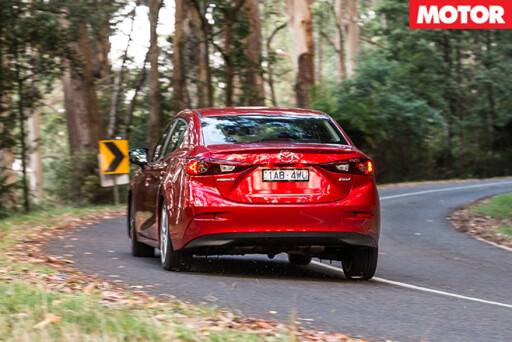 Mazda has long managed to imbue even its most humble models with real driver appeal, so it should come as no surprise that the latest sporty 3 is no exception. You’d never guess (and I suspect most owners will never discover) the level of talent that lies underneath its handsome, yet conservative, exterior.
Mazda has long managed to imbue even its most humble models with real driver appeal, so it should come as no surprise that the latest sporty 3 is no exception. You’d never guess (and I suspect most owners will never discover) the level of talent that lies underneath its handsome, yet conservative, exterior.
You can more or less drive the wheels off it, largely untroubled by ESP. Only the brakes stand out as inadequate, a certain enthusiastic editor pulls up with four bonfires lit under its wheelarches. Little wonder Mazda upgraded the stoppers for the Albert Park celebrity race.
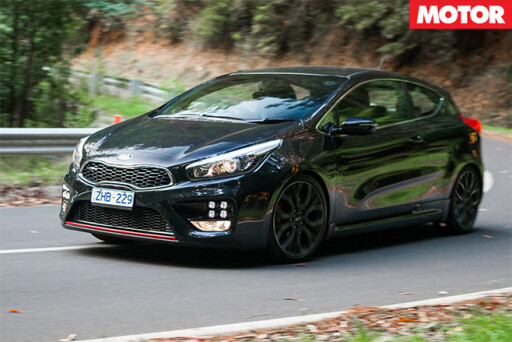 Which brings us to the Kia. Usually, we have at least some idea of what a car is going to feel like before we drive it, but the ProCeed was a genuine unknown. It certainly looks the part: squat and aggressive, its sharply-raked three-door body and LED-filled visage marking it as the glamour of the group. But it only takes a couple of corners to realise there’s substance to match the style.
Which brings us to the Kia. Usually, we have at least some idea of what a car is going to feel like before we drive it, but the ProCeed was a genuine unknown. It certainly looks the part: squat and aggressive, its sharply-raked three-door body and LED-filled visage marking it as the glamour of the group. But it only takes a couple of corners to realise there’s substance to match the style.
As opposed to the Korean-built, torsion-beam equipped i30 SR, the Euro-built ProCeed arrives Down Under (the only market other than Europe to receive the car) with a multi-link rear end, which gave Kia’s local handling wizard, Graeme Gambold, more scope to fiddle. Whatever he did, it worked.
The ProCeed is firm but compliant, the steering nicely weighted and the fitment of proper tyres – in this case Michelin Pilot Sport 3s – pays dividends in every area, improving braking, cornering and traction. It’s not hugely playful in the manner of a Fiesta ST, but still leaves every other car here in its dust on our chosen test road.
Inside, the Kia continues to impress.
 The seats and steering wheel are top-notch, most of the usual niceties (Bluetooth, reverse camera, climate control, etc) are present – though sat-nav is conspicuous by its absence – and small touches like the red stitching and colour LCD instrument display help justify the higher price. Plenty of room in the back, too, despite the three-door bodyshell.
The seats and steering wheel are top-notch, most of the usual niceties (Bluetooth, reverse camera, climate control, etc) are present – though sat-nav is conspicuous by its absence – and small touches like the red stitching and colour LCD instrument display help justify the higher price. Plenty of room in the back, too, despite the three-door bodyshell.
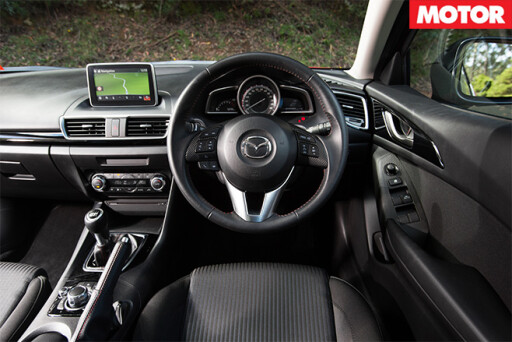 Also scoring points is the Mazda. Our test car is a base SP25 (plus $1300 ‘Safety Pack’), yet you’d never know it with piano black inserts and splashes of faux carbonfibre. It’s not as overtly sporty as the Kia, but feels classier, with features like the seven-inch colour infotainment display, controlled by a BMW iDrive-like system mounted on the centre console.
Also scoring points is the Mazda. Our test car is a base SP25 (plus $1300 ‘Safety Pack’), yet you’d never know it with piano black inserts and splashes of faux carbonfibre. It’s not as overtly sporty as the Kia, but feels classier, with features like the seven-inch colour infotainment display, controlled by a BMW iDrive-like system mounted on the centre console.
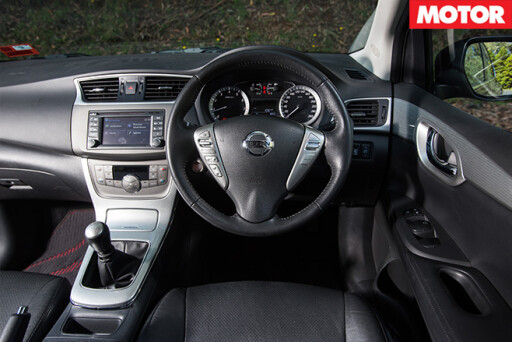 It’s certainly in a different league to the Pulsar. The Nissan’s interior is cavernous, with masses of rear-seat space, but it also feels about as premium as one of those yellow-roofed toy cars that kids knock about in.
It’s certainly in a different league to the Pulsar. The Nissan’s interior is cavernous, with masses of rear-seat space, but it also feels about as premium as one of those yellow-roofed toy cars that kids knock about in.
There’s plenty of kit (though at a higher price than the Mazda, Hyundai and Holden), but the plastics are hard and scratchy and it doesn’t feel particularly well put together. Editor Dylan says it reminds him of a Singapore taxi.
Had we had a mechanically identical SRi-V on this test (we could have had one, but it would have been automatic) rather than the cheaper, sparser SRi, the Holden and the Hyundai would be a close match. Virtually identical in equipment levels, the Cruze offers arguably the stronger case with its cheaper $26,490 sticker, though that’s assuming you can live with the colour scheme.
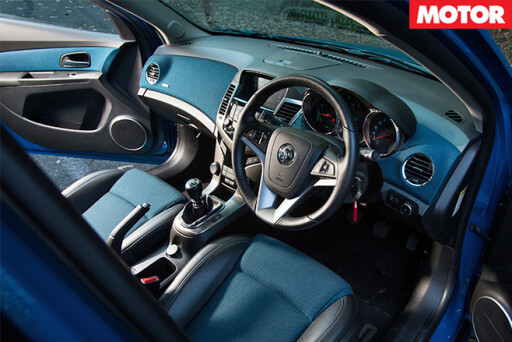 In attempting to enliven the Cruze’s interior, Holden has added large swathes of body-coloured cloth, which gives the whole thing a strangely aquatic vibe. Whether that’s preferable to the Hyundai’s ‘50 Shades of Grey Plastic’ effort is likely to come down to buyer preference, or personality.
In attempting to enliven the Cruze’s interior, Holden has added large swathes of body-coloured cloth, which gives the whole thing a strangely aquatic vibe. Whether that’s preferable to the Hyundai’s ‘50 Shades of Grey Plastic’ effort is likely to come down to buyer preference, or personality.
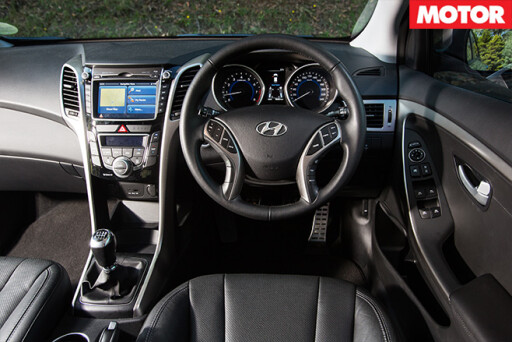 Over two days of testing and many hundreds of kilometres, it quickly becomes apparent this comparo contains four closely-matched cars, and one that is head and shoulders above the pack. And the tail end of that bottom four is occupied by the Nissan Pulsar SSS.
Over two days of testing and many hundreds of kilometres, it quickly becomes apparent this comparo contains four closely-matched cars, and one that is head and shoulders above the pack. And the tail end of that bottom four is occupied by the Nissan Pulsar SSS.
It’s fast and spacious, so if you have to move a lot of large objects in a hurry, perhaps the Pulsar is the car for you. But I doubt it. It feels cheap, sounds awful and its sub-par dynamics mean it’s just not that much fun to drive.
Next up is Holden’s Cruze SRi, though for almost polar opposite reasons to the Pulsar. Holden’s local engineers have created a car with a fine ride/handling balance that feels well suited to Aussie roads.
Trouble is, any fire in the chassis is extinguished by that wet blanket of an engine, and its performance barely qualifes as tepid, let alone hot. Yes, it’s cheap, but so is taking the bus.
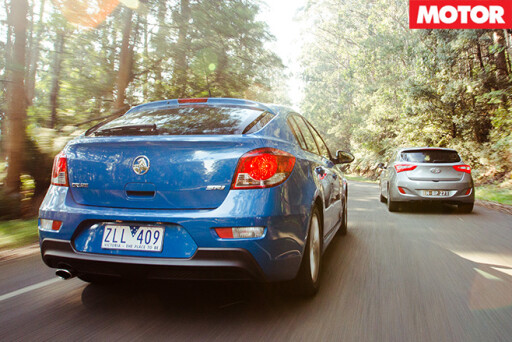 Hyundai’s i30 SR has third place all sewn up and was knocking on the door of second – until it started to rain. The car’s diabolical lack of grip in the wet goes beyond fun to alarming, which is a shame as there’s a lot to enjoy in this package. It’s not fast, but it revs out cleanly and the chassis is playful and engaging. Just strap some better tyres on it, Hyundai, please!
Hyundai’s i30 SR has third place all sewn up and was knocking on the door of second – until it started to rain. The car’s diabolical lack of grip in the wet goes beyond fun to alarming, which is a shame as there’s a lot to enjoy in this package. It’s not fast, but it revs out cleanly and the chassis is playful and engaging. Just strap some better tyres on it, Hyundai, please!
This leaves Mazda’s new SP25 in the runner-up spot. It looks and feels so normal it’s almost like Mazda made it fun to drive by pure accident. If you have a non-enthusiast partner or parent who is looking for something sensible that you can occasionally steal for a twisty-road thrash, then the SP25 is that car.
Take the best bits from all four cars – say, the i30’s playful chassis, the Pulsar’s gutsy engine, the Cruze’s grippy tyres (and price) and the SP25’s interior and overall polish – and you’d have quite a car. It might even be good enough to challenge the car that wins this test by an avalanche, the ProCeed GT.
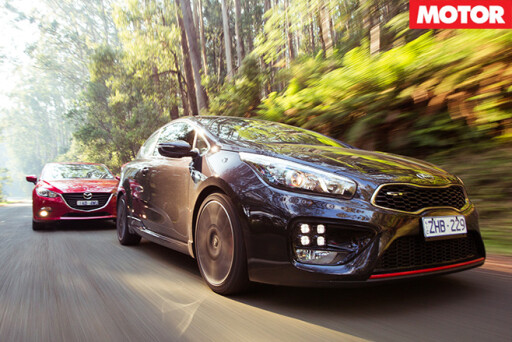 Yes, a Kia wins a MOTOR test. Put away your prejudice, the ProCeed isn’t just impressive for a first effort, it’s impressive full-stop. The most focused car here, it’s the fastest against the clock and the most enjoyable to drive with the best gearchange, steering and brakes, yet it demands few, if any, compromises in day-to-day use.
Yes, a Kia wins a MOTOR test. Put away your prejudice, the ProCeed isn’t just impressive for a first effort, it’s impressive full-stop. The most focused car here, it’s the fastest against the clock and the most enjoyable to drive with the best gearchange, steering and brakes, yet it demands few, if any, compromises in day-to-day use.
In fact, such was the Kia’s winning margin, we thought we’d organise it a much harder test.

COMMENTS